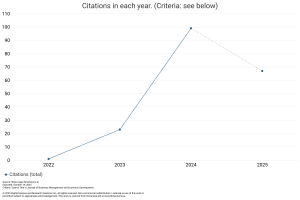Analysis of Differences Food Industry and Footwear Industry Sectors on Economic Growth of Industrial Sector in Mojokerto Regency
DOI:
https://doi.org/10.59653/jbmed.v2i03.948Keywords:
Economic Growth, Industrial Sector, Number of Industries, Unemployment, Fraudulent InvestmentAbstract
The growth of the industrial sector has a significant impact on economic growth in a region. The industrial sector that dominates Mojokerto Regency is the food and footwear industry. Industrial development can be seen through the number of industries, workforce and investment. Even though they both dominate, the development of the footwear industry has decreased compared to the food industry which is increasingly developing well. The aim of this research is to determine the differences between the food and footwear industries and their influence on the economic growth of the industrial sector in Mojokerto Regency. This research is important because it not only discusses the differences between the food and footwear industries but also looks at the influence of these two industries on the economic growth of the industrial sector. This research uses a different test analysis method independent sample t-test and multiple linear regression analysis on time series data. The research results show that the number of industries and workers in the food and footwear industrial sector does not make a difference to the economic growth of the industrial sector, while investment in the food and footwear industrial sector has a difference to the economic growth of the industrial sector. Then the number of industries, workforce and investment in the food industry partially and simultaneously influence the economic growth of the industrial sector. While labor and investment in the footwear industry have an influence on economic growth, the number of industries in the footwear industry has no effect on the economic growth of the industrial sector in Mojokerto Regency.
Downloads
References
Achsoni, F. L., Teknologi, F., & Informatika, D. A. N. (2019). Design and build application for submitting activities to the Mojokerto city industry and trade department.
Arsyad, L. (2015). Development Economics and Economic Development. Sustainable Development Economics, 05(01), 1–37.
Ayem, S., & Pratama, D. D. (2018). The Influence of Economic Growth, General Allocation Funds, Special Allocation Funds and Original Regional Income on Capital Expenditures in the Yogyakarta Special Region Province for the 2011-2016 Period. Dewantara Accounting Journal, 2(2), 169–182. https://doi.org/10.29230/ad.v2i2.2987
Mojokerto Regency Central Statistics Agency. (2023). Mojokerto Regency in Figures Mojokerto Regency in Figures 2023. 7823–7830.
Febriyani, A., & Anis, A. (2021). The Influence of Economic Growth, Investment and Human Development Index on Inequality of Income Distribution in Indonesia. Journal of Economic and Development Studies, 3(4), 9. https://doi.org/10.24036/jkep.v3i4.12375
Julian, N. A., Melati, P., Utami, E. M., Rahmaillah, W., Purwaningsih, V. T., & Aida, N. (2023). Analysis of the Influence of Investment and Labor Levels on the GDP of Lampung Province for the 2012-2021 Period. Analysis, 13(2), 334–347. https://doi.org/10.37478/als.v13i2.2878
Maulidya, R. (2021). Analysis of the Effect of Economic Growth and Government Expenditures on the Human Development Index (Study of All Provinces in Indonesia 2015-2018). Brawijaya University, 1–26.
Nasrullah, S. (n.d.). Factors influencing the decline in shoe traders at the Trowulan shoe wholesale center (PPST) in Mojokerto district.
Nuraini, E. (2017). THE INFLUENCE OF ECONOMIC GROWTH AND EDUCATION LEVELS ON INCOME DISPARITIES IN THE GERBANGKERTOSUSILA AREA. Economics of Education and Entrepreneurship, 5(1), 52–67.
Ratih Primandari, N. (2019). The influence of economic growth, inflation and unemployment on poverty levels in South Sumatra. Journal of Development Economics, 16(1), 1–10. https://doi.org/10.29259/jep.v16i1.8856
Rosita, R. (2020). The Influence of the Covid-19 Pandemic on MSMEs in Indonesia. Business Lantern Journal, 9(2), 109. https://doi.org/10.34127/jrlab.v9i2.380
Siadari, F. (2023). Analysis of the Effect of Economic Growth on Poverty Levels in North Sumatra. JKA, 9(2).
Silitonga, F., Neneng, S., & Takari, D. (2021). Analysis of the Effect of Capital Investment and Wages on Labor Absorption in the Rattan Weaving Industry in Palangka Raya City. JEMBA: Journal of Development Economics, Management and Business, Accounting, 1(1), 1–8. https://doi.org/10.52300/jemba.v1i1.2486
Sukirno, S. (2015). Introductory Macroeconomic Theory (Keti Edition). PT Raja Grafindo Persada.
Virdausya, S., Balafif, M., & Imamah, N. (2020). The Impact of Tofu Industry Externalities on Tropodo Village Income, Krian District, Sidoarjo Regency. Bharanomics, 1(1), 1–8. https://doi.org/10.46821/bharanomicss.v1i1.11
Downloads
Published
How to Cite
Issue
Section
License
Copyright (c) 2024 Adinda Yumna, Sishadiyati

This work is licensed under a Creative Commons Attribution-ShareAlike 4.0 International License.
Authors who publish with this journal agree to the following terms:
- Authors retain copyright and grant the journal right of first publication with the work simultaneously licensed under a Creative Commons Attribution-ShareAlike that allows others to share the work with an acknowledgement of the work's authorship and initial publication in this journal.
- Authors are able to enter into separate, additional contractual arrangements for the non-exclusive distribution of the journal's published version of the work (e.g., post it to an institutional repository or publish it in a book), with an acknowledgement of its initial publication in this journal.
- Authors are permitted and encouraged to post their work online (e.g., in institutional repositories or on their website) prior to and during the submission process, as it can lead to productive exchanges, as well as earlier and greater citation of published work (See The Effect of Open Access).





























